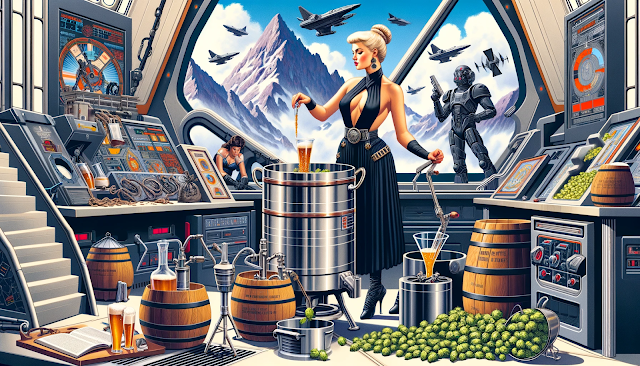Brewing beer is a remarkable blend of craftsmanship and scientific know-how. For those passionate homebrewers who aspire to boost the Alcohol By Volume (ABV) of their beer, it becomes imperative to delve deeper into the intricate web of factors and ingredients that hold sway over this pivotal measurement. In this extensive exploration, we will embark on a journey to unveil the multifaceted world of brewing, shedding light on the complex interplay between sugars and a myriad of other essential elements that contribute to elevating the ABV in beer.
Sugars, undoubtedly, play a central role in the quest for higher ABV in beer. These simple and complex carbohydrates are the very foundation upon which the alcohol content of beer is built. In the brewing process, yeast consumes these sugars through fermentation, converting them into alcohol and carbon dioxide. The amount and type of sugars used directly impact the final ABV of the beer.
One of the primary factors that influence ABV is the choice of fermentable sugars. Homebrewers have a plethora of options at their disposal, ranging from malted grains like barley and wheat to adjuncts such as corn, rice, or even unconventional sources like honey or fruit.
Each type of sugar imparts unique flavors and characteristics to the beer, making the selection a critical decision in the pursuit of higher ABV.
Understanding Alcohol By Volume (ABV)
ABV represents the percentage of alcohol in relation to the total volume of beer. Elevating ABV means increasing this percentage, which requires an understanding of which sugars can be effectively fermented.Boosting ABV: The Ingredients
Several ingredients can be used to increase the ABV of your homebrew:Hopped Malt Extract (HME), Liquid Malt Extract (LME), and Dry Malt Extract (DME)
In the world of homebrewing, we encounter a trio of essential malt extracts, namely Hopped Malt Extract (HME), Liquid Malt Extract (LME), and Dry Malt Extract (DME). These extracts serve as the fundamental sources of fermentable sugars, serving as the lifeblood of yeast fermentation.
When it comes to boosting the Alcohol By Volume (ABV) of your brew, these malt extracts play a crucial role. Even a seemingly modest addition of an extra pound or approximately 1/2 kilogram of DME or LME can result in a notable increase in your beer's ABV, typically in the range of about 0.5%.
However, it's important to recognize that this increase in ABV comes with its own set of considerations. The introduction of additional malt extracts can impart a maltier character to your beer, potentially altering its flavor profile and body.
Moreover, the heightened malt content might offset the balance with hop bitterness, so it's essential to carefully weigh the trade-offs between ABV enhancement and the overall taste and aroma characteristics you aim to achieve in your brew.
Table Sugar, Corn Sugar (Dextrose), and Brown Sugar
Table Sugar, Corn Sugar (Dextrose), and Brown Sugar are versatile ingredients in the arsenal of homebrewers, capable of wielding a significant influence on the Alcohol By Volume (ABV) of your brew. Their inclusion in the brewing process can not only elevate the ABV but also impart distinct characteristics to the final product.When incorporated into the wort, these sugars have the potential to render the beer drier, thereby impacting its body and mouthfeel, making it a crucial consideration for brewers seeking specific flavor profiles and textures in their creations.
Furthermore, the addition of these sugars may have an intriguing side effect on hop bitterness. As the sugars are consumed by yeast during fermentation, the resulting increase in alcohol content can enhance the perception of hop bitterness in the beer. This interplay between sweetness and bitterness adds another layer of complexity to the brewer's palette, allowing for the fine-tuning of the beer's flavor profile.
Another noteworthy aspect is the potential for these sugars to influence the color of the beer. In many recipes, especially those aiming for a lighter hue, the inclusion of table sugar, corn sugar, or brown sugar can lead to a noticeable lightening of the beer's color. This visual aspect can be significant for brewers looking to achieve specific visual aesthetics in their beer, further illustrating the nuanced impact of these sugars on the overall sensory experience.
Furthermore, the addition of these sugars may have an intriguing side effect on hop bitterness. As the sugars are consumed by yeast during fermentation, the resulting increase in alcohol content can enhance the perception of hop bitterness in the beer. This interplay between sweetness and bitterness adds another layer of complexity to the brewer's palette, allowing for the fine-tuning of the beer's flavor profile.
Another noteworthy aspect is the potential for these sugars to influence the color of the beer. In many recipes, especially those aiming for a lighter hue, the inclusion of table sugar, corn sugar, or brown sugar can lead to a noticeable lightening of the beer's color. This visual aspect can be significant for brewers looking to achieve specific visual aesthetics in their beer, further illustrating the nuanced impact of these sugars on the overall sensory experience.
Using Honey to increase ABV
Honey, a remarkable fermentable sugar with its distinct character, introduces a layer of subtle flavors and complexity to the brewing process.When incorporated into the beer recipe, even a relatively small amount of approximately 1 pound of honey can wield a noticeable influence on the Alcohol By Volume (ABV), elevating it by approximately 0.7%. This seemingly modest addition of honey can work wonders in enhancing the overall profile of the brew, introducing delicate floral and aromatic notes that captivate the palate.
Nevertheless, the art of using honey in brewing demands a judicious approach. While it has the power to elevate ABV and enrich the flavor profile, an excessive amount of honey can potentially tip the balance and lead to a beer that is overly dry.
Finding the sweet spot in the quantity of honey added is crucial to strike that perfect equilibrium between increased alcohol content and the desired level of sweetness, ensuring that the beer remains harmonious and enjoyable to the last drop
The Risks of Overloading Sugars
Maintaining a prudent approach to sugar utilization is of paramount importance when aiming to enhance the Alcohol By Volume (ABV) of your beer. A general guideline to bear in mind is that no more than a third of your beer's ABV should be derived from non-malt sugars.This principle ensures that the yeast is not overburdened and fermentation proceeds smoothly. The repercussions of excessive sugar can be multifaceted – not only does it place strain on the yeast, potentially leading to a sluggish fermentation, but it can also impart unwelcome changes to the beer's flavor profile.
To effectively address this challenge, one can explore strategies such as augmenting yeast nutrients or introducing a secondary yeast strain into the fermentation process, particularly one that exhibits a higher degree of alcohol resistance.
Temperature and Brewing control for ABV
Maintaining consistent temperature throughout the brewing process stands as an indisputable cornerstone of achieving brewing excellence. Temperature fluctuations, no matter how slight, can wield a detrimental impact on the delicate and intricate fermentation process.When the ambitious goal is to elevate the Alcohol By Volume (ABV) of the beer being crafted, the vigilance in temperature management becomes even more paramount. It is imperative for homebrewers to keep a watchful eye on the temperature conditions and be prepared to make meticulous incremental adjustments as needed.
This unwavering dedication to temperature control not only safeguards the integrity of the fermentation but also ensures that the yeast, the driving force behind alcohol production, operates optimally in the pursuit of crafting a beer with a higher ABV.
A Final Thought: Brewing as Art and Science
While increasing ABV is a fascinating challenge, the primary goal is to craft a beer that satisfies your taste. If you're looking to counteract sweetness, consider exploring styles like "Gose," which incorporates salt. Brewing is a blend of creativity and precision, and experimenting with different ingredients and techniques can lead to uniquely satisfying beers.




